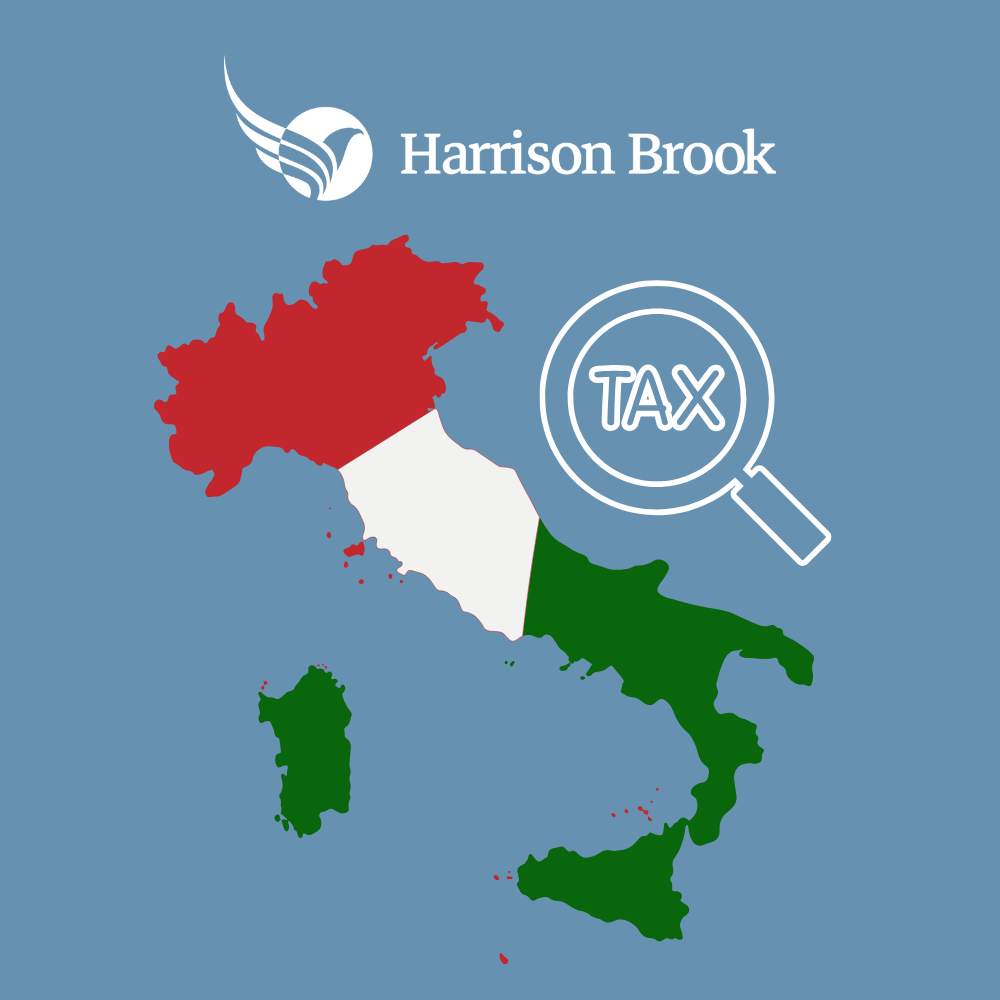
For many high-net-worth individuals, Italy has become one of the most attractive relocation destinations in Europe. This is not only for its lifestyle and culture but also because of a unique regime: the 100k tax rule in Italy. Introduced in 2017, it is designed to attract wealthy foreigners by offering a flat annual tax on worldwide income. The 100k tax rule was established by a specific law decree, reflecting the Italian government’s commitment to introducing this new regime and maintaining a favorable tax environment for high-net-worth individuals.
In this article we explain what the 100k rule is, how it works, who can apply, and how it compares to other tax regimes.
Understanding the 100k Flat Tax Regime
The 100,000 euro tax rule in Italy allows new residents to pay a flat €100,000 per year on all foreign-sourced income, regardless of the amount earned. For example, whether you earn €500,000 or €50 million outside Italy, the liability remains €100,000 annually. This payment is an annual flat tax, often referred to as an annual lump sum or lump sum, under Italy’s special tax regime for new residents.
It was introduced to compete with other European countries offering preferential regimes, such as the UK non-dom or Portugal’s NHR. The aim is to attract entrepreneurs, investors, and internationally mobile professionals to base themselves in Italy. This form of flat taxation simplifies compliance and offers predictability for eligible individuals.
Who Qualifies for the 100k Rule Based on Tax Residence?
To be eligible, applicants must:
- Become a resident of Italy and tax resident (spending more than 183 days a year there), meeting the fiscal years requirement.
- Not have been tax residents of Italy for at least nine years in the ten fiscal years preceding their move.
The scheme can be extended to family members, with an additional flat €25,000 per person annually per dependant.
Why Are Millionaires Moving to Italy?
Several reasons explain the popularity:
- Tax certainty: capped at €100,000 regardless of global income.
- Estate planning advantages: simplified treatment of wealth held abroad, including favorable treatment regarding inheritance taxes, inheritance and gift tax, and gift tax on foreign assets. The regime exempts foreign real estate and financial assets from Italian inheritance and gift tax, providing significant planning opportunities for high-net-worth individuals with financial assets held outside Italy.
- Lifestyle appeal: Italy’s culture, cuisine, and climate make relocation attractive.
- Competitive with other regimes: especially when compared with higher tax jurisdictions.
It is no surprise that the press frequently reports on wealthy families and even celebrities relocating to Italy under this scheme.
How Are Foreign Income and Foreigners Taxed in Italy Outside the 100k Rule?
Normally, Italy taxes residents on worldwide income at progressive tax rates of up to 43 percent, plus regional and municipal surcharges. These progressive tax rates are applied to different income brackets, with higher rates for higher levels of income. Tax residents are liable for taxes on their foreign incomes as well as Italian-sourced income. For foreigners not eligible or not choosing the 100k scheme, this can mean high effective taxation.
By contrast, the flat tax regime avoids these progressive rates, providing certainty and often significant savings. Individuals who do not opt for the 100k regime or whose eligibility ends remain subject to the standard Italian tax system.
Key Comparisons: 70 Percent, 90 Percent and 7 Percent Rules
The Italian system also offers alternative flat tax regimes, some of which are part of a new regime introduced by the Italian government, that sometimes create confusion. These regimes can cover a broad range of income and gains from foreign sources:
- 70 percent tax rule: Certain inbound workers can exempt 70 percent of their employment income from tax.
- 90 percent rule: In some southern regions, up to 90 percent exemption applies.
- 7 percent rule: Foreign retirees who establish residence in designated regions of southern Italy may pay just 7 percent flat tax on their foreign income, including pension income (such as annuities and lump-sum payments), self employment income, director’s fees, and other qualifying foreign income and gains.
These regimes are separate from the 100k rule and usually apply to different taxpayer profiles.
What is the Maximum Tax in Italy?
Outside special regimes, the maximum income tax rate in Italy is 43 percent, before local surcharges. This puts Italy among the higher tax countries in Europe.
Under the 100k rule, however, liability is capped and cannot rise regardless of global earnings. For many high-income families this results in a significant difference compared with paying tax in their previous country of residence.
Are Taxes Higher in Italy or the UK?
The UK applies progressive rates up to 45 percent, along with complex rules for non-doms. Recent announced plans to reform the UK tax regime for non-domiciled individuals have further reduced the benefits for non-doms, making Italy’s 100k scheme comparatively more attractive for internationally mobile professionals. When considering relocation, it is crucial to establish a clear break from UK tax residence to fully benefit from the Italian regime and avoid unintended UK tax consequences.
How Much Tax Do I Need to Pay on €100,000?
If you choose the 100k regime, you owe €100,000 irrespective of the actual amount of foreign income. Domestic Italian-sourced income, however, remains taxable under ordinary rules.
The election to apply the 100k regime must be made in the annual tax return for the relevant fiscal year.
For those not on the regime, €100,000 of taxable income in Italy would attract progressive rates, averaging significantly less than the flat levy but with no cap on higher earnings.
Advance Tax Ruling: Securing Certainty with the 100k Regime
For high net worth individuals considering the Italian flat tax regime, securing an advance tax ruling from the Italian Revenue Agency is a vital step in ensuring a smooth and confident transition to tax residence in Italy. The advance tax ruling provides a binding decision from the Italian tax authorities on your eligibility for the flat tax regime, giving you clarity and certainty about your future tax liability before you make the move.
The process begins by submitting a detailed application to the Italian tax authorities, outlining your personal and financial circumstances. This includes information about your foreign income, foreign investments, tax residence history, and any foreign assets you hold. The Italian Revenue Agency will review your submission and, typically within 90 days, issue a formal ruling confirming whether you qualify for the flat tax rate of €100,000 on your non-Italian sourced income. This includes all types of foreign income, such as dividends, interest, and capital gains from foreign investments.
One of the key advantages of obtaining an advance tax ruling is the peace of mind it offers. With a binding assessment in hand, you can confidently plan your tax residence to Italy, knowing that your eligibility for the beneficial regime is secure. This is especially important for individuals with significant foreign assets, as the Italian flat tax regime exempts you from wealth tax, inheritance tax, and donation tax on foreign assets, and replaces ordinary income taxes with a substitute tax on your worldwide income.
The advance tax ruling also simplifies your reporting obligations under Italian tax law. Instead of filing complex tax returns for your foreign income and assets, you benefit from streamlined compliance requirements, making it easier to manage your finances as an Italian tax resident.
For non-EU citizens, the process may also involve obtaining a residence permit, such as an Investor Visa, to establish your tax residence in Italy. The advance tax ruling ensures that once your residence permit is secured, your tax position is clear and compliant with Italian law.
In summary, the advance tax ruling is an essential tool for high net worth individuals seeking to take advantage of the Italian flat tax regime. It provides certainty, simplifies your tax liability, and ensures you remain compliant with Italian tax authorities, allowing you to enjoy the many benefits of life as an Italian tax resident under this special regime.
Limitations of the 100k Regime for Family Members
While attractive, the regime is not suitable for everyone:
- It lasts a maximum of ten years. The regime applies for up to ten fiscal years starting from the year the individual becomes an Italian tax resident.
- Eligibility depends on the number of fiscal years preceding the move to Italy in which the applicant was not a tax resident. Typically, you must have been non-resident for at least nine out of the ten fiscal years prior to applying.
- Certain capital gains realised from the disposal of specific shareholdings may not be covered by the flat tax and could be subject to progressive tax rates during the initial fiscal years.
- Italian-sourced income is still subject to normal taxation.
- Social security contributions may still apply.
- Careful planning is needed to avoid double taxation in certain circumstances.
FAQs – What is the 100k Tax Rule in Italy?
What is the 30 percent tax rule in Italy?
This applies to specific categories of workers benefiting from reduced taxable income when relocating to Italy. It is separate from the 100k flat tax.
Do Italian dual citizens pay taxes in both countries?
It depends on tax residency and applicable treaties. Dual citizens resident in Italy are subject to Italian tax, but relief may be available through double taxation agreements.
Is there a tax-free limit in Italy?
Yes, personal allowances exist, but these are relatively low compared to other European systems.
How do I avoid the 100k tax trap?
Seek specialist cross-border advice before applying. Incorrect structuring can mean missing out on the benefits or inadvertently triggering taxation elsewhere.
Which country pays the maximum tax?
Among major economies, Italy, France, and some Nordic countries have some of the highest marginal tax rates. The 100k regime is Italy’s solution to stay competitive.
Why Professional Advice is Essential
Choosing whether to apply for the 100k regime or an alternative requires careful analysis. Factors such as your global income mix, investment structures, family situation, and long-term plans will determine suitability.
Cross-border planning ensures you maximise the benefits while remaining compliant both in Italy and in any other relevant jurisdictions.
Get in touch
At Harrison Brook, we specialise in guiding internationally mobile professionals and families through complex tax and financial decisions. If you are considering relocating to Italy or exploring the 100k tax rule, our advisers can provide clarity, personalised strategies, and peace of mind.
Speak to Harrison Brook today and discover how to make the most of your global wealth while enjoying life in Italy.



